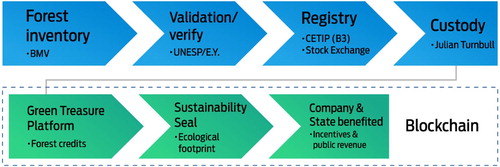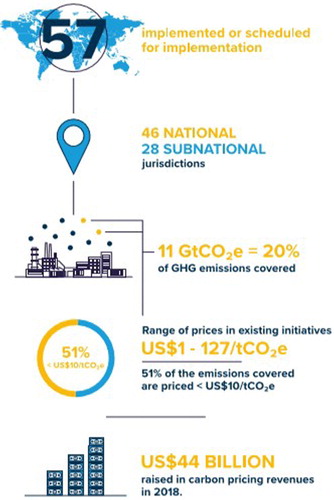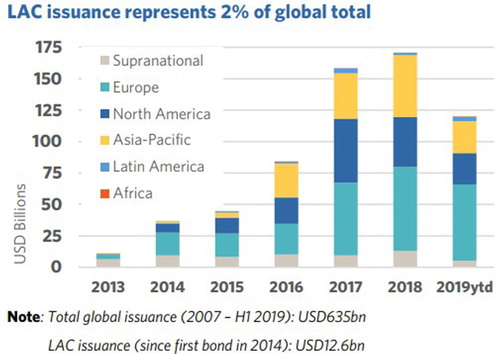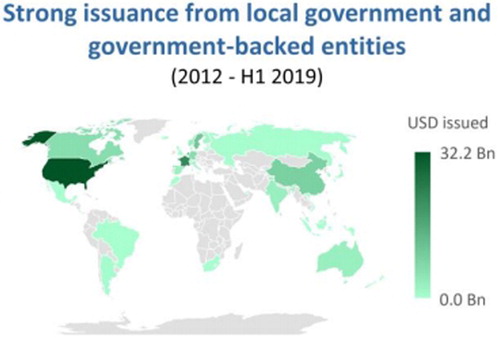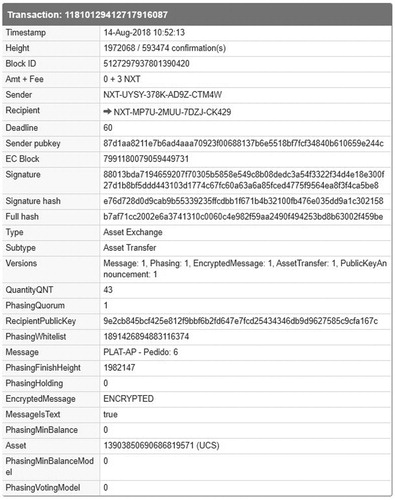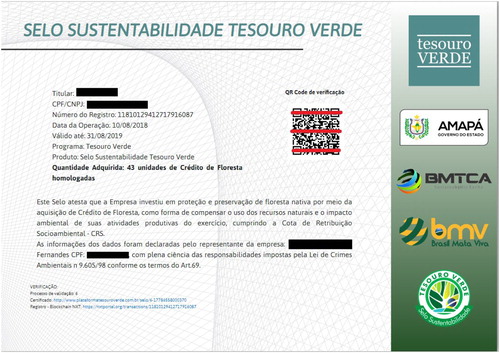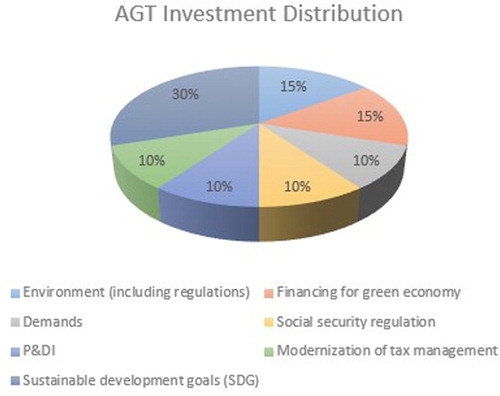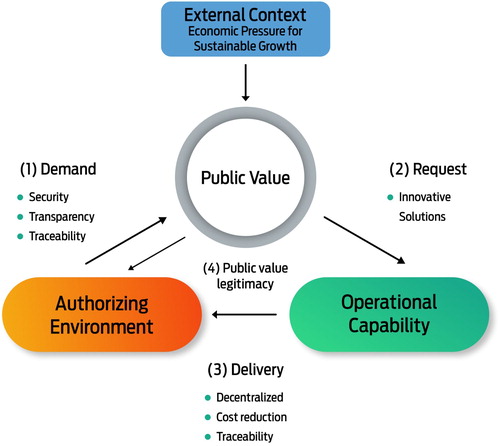ABSTRACT
Blockchain is a recent certification technology that has strong potential to transform many business models and to have a social impact by providing solutions, including governance and sustainability. This paper presents a case study on a pioneering blockchain application on an online platform to negotiate forest credits issued for environmental services. The context is the management of the Green Treasure Program in the State of Amapá in the Amazon region of Brazil, a complex and interesting case for research. The purpose of this study is to identify how blockchain can contribute to the negotiation of environmental investments between the public and private sectors. For this purpose, we conducted qualitative research, a case study, using the lens of the theory of public value and an interpretative perspective. We seek to understand the connections between public value theory and the blockchain application.
1. Introduction
The purpose of this study is to identify how blockchain can contribute to the negotiation of environmental investments between the public and private sectors. To fulfill our objective, we selected the use of blockchain in the Amapá Green Treasure (AGT), which operates through a platform for trading forest credits or titles generated from the conservation of native forests. The AGT (Tesouro Verde, Citation2019) is a kind of carbon pricing initiative at the subnational level that is classified by the World Bank as results-based climate finance (RBCF) and is part of the global carbon market as reinforced by the Paris Agreement. Our analysis unit is the State Government of Amapá, located in the Amazon region of Brazil, which recently adopted blockchain to assist in the management of AGT. One of the state government’s main objectives is to foster business for the construction of a sustainable economic matrix.
Recent research on the use of blockchain has identified a lack of government projects to provide social services (Ølnes et al., Citation2017). Other references address the use of this technology for projects that offer sustainability with high transformative power (Kewell et al., Citation2017). The articles selected in our literature review suggest the use of blockchain to provide trust, transparency, and traceability in transactions but also address unresolved issues, such as security, privacy, auditability, control, anonymity, and scalability (Kokina et al., Citation2017; Macrinici et al., Citation2018; Manski, Citation2017). We also identified that more than 80% of the articles dealt with blockchain related to cryptocurrencies (mainly Bitcoin) and that few empirical studies adopted a theoretical approach. Additionally, most of the articles have been published in the previous two years, a few of them in the main information systems (IS) journals and at the vast majority of conferences, and have made recommendations for studies analyzing the value generated by blockchain for society and the government (Hawlitschek et al., Citation2018; Macrinici et al., Citation2018; Risius & Spohrer, Citation2017; Yli-Huumo et al., Citation2016).
In this context, we conducted a qualitative study with an interpretative perspective based on Stake’s case study strategy (Stake, Citation1995 and Citation2008) and Moore’s Public Value Theory (Moore, Citation1995). This research was carried out with the project’s main actors in the public sector, the technology and methodology supplier, and the seven companies that first joined the program to obtain the Sustainability Seal. Through semistructured interviews and document analysis, we seek to answer the following research question:
1.1. How can blockchain technology contribute to negotiations of environmental investments between the public and private sectors?
The State of Amapá represents a complex and stimulating context for research: its economic matrix is incipient, it has a poor logistical infrastructure, it faces major difficulties in attracting investments, and it experiences socioeconomic isolation. In contrast, what has not yet been accounted for in the GDP of the State of Amapá is natural wealth: according to the latest Earth Innovation Institute study (Stickler et al., Citation2018), it is one of the most preserved subnational states in Brazil and the Amazon. This scenario contributed to the availability of approximately 45 million dollars in forest credits for negotiation at the AGT when the program was launched in August 2018. For this reason, our motivation is to analyze a pioneering blockchain application in the green economy.
This study contributes to the literature addressing the use of blockchain in government projects that promote sustainability. This study can assist public managers and IS scholars working on the design of sustainable business models in developing countries. We integrate the blockchain values into the strategic public value triangle, proposing a framework to explain how blockchain contributes to creating public value. We also highlight the importance of blockchain solutions connected with United Nations (UN) Sustainable Development Goals (SDGs), analyzing a unique case from a complex context.
2. Theoretical background
Since it emerged in 2008 (Nakamoto, Citation2008), there have been several definitions for blockchain: a distributed accounting technology (Denny et al., Citation2017), a distributed database (Ferreira et al., Citation2017), distributed records (Wu & Tran, Citation2018) or a distributed ledger technology (DLT; Ølnes et al., Citation2017). Regardless of the definition, all approaches agree that decentralization is one of the benefits that grants this technology highly transformative power in several business models (Diniz, Citation2017).
Blockchain is a technology that can be used ‘for any change in ownership and storage of important information and documents such as certificates, licenses, government decisions and legislation’ (Ølnes et al., Citation2017, p. 355). It can be transacted in the blockchain operations of the registration of property, identity, copyright, votes and, above all, smart contracts, which ‘are the performance automation of contracts that only execute when the prespecified conditions are fulfilled, eliminating the need for third party resolution’ (Kewell et al., Citation2017). Among the benefits that blockchain can generate are trust, transparency, traceability, security, auditability, control, and anonymity. Cost reduction and scalability are still limited to discussions but were considered in this research (Casino et al., Citation2019; Kokina et al., Citation2017; Macrinici et al., Citation2018).
Our systematic literature review (SLR) included articles that addressed the use of blockchain in government or in sustainability projects. SLR was performed from August to October 2018 in the EBSCO, Jstor, Scielo, Web of Science, and Google Scholar databases. The searched keywords were a combination of ‘blockchain’, ‘government’ and/or ‘sustainability’. After having read the abstracts and the introduction of the first selection, our final set included 33 articles. We excluded all articles referring to cryptocurrencies. Among the 33 selected texts were 10 articles that confirmed the research gap concerning the applications of this technology in governmental projects around sustainability (Engelenburg et al., Citation2017; Ferreira et al., Citation2017; Hawlitschek et al., Citation2018; Issa, Citation2018; Kshetri, Citation2018; Macrinici et al., Citation2018; Notheisen et al., Citation2017; Risius & Spohrer, Citation2017; Yli-Huumo et al., Citation2016). There has been significant growth in the demand for sustainable products, mainly due to the demand of consumers for more responsible supply chains. Goods have been produced using inputs with a lower environmental impact and require transparency in accountability and certification of the origin of the resources (Fowler, Citation2018). Blockchain can generate billions of dollars in the supply chain of the environment, providing, beyond social welfare, a more efficient management of natural resources and reaching a win-win relationship between the state and society (Saberi et al., Citation2018). In line with the objectives of the UN Agenda 2030, ‘[…] the adoption of the blockchain has important implications for the goals and targets towards more sustainable development’ (Denny et al., Citation2017).
The platform used by AGT, the IT artifact of our study, aims to create a transparent, traceable and secure management of resources, guaranteeing the distribution of these resources to their main destinations: 15% for the environment, 15% for sustainable development and 30% for the objectives of sustainable development. Following the guidelines of Benington and Moore (Citation2011) concerning the use of public value theory, we aimed to identify how blockchain can contribute to negotiations of environment investments between public and private sectors. For this objective, public value theory was useful for shaping the field work and the analysis of the results.
2.1. Public value theory
When analyzing environmental services negotiations and the technology platforms for these services in the context of government, we adopt Moore’s theory of public value (Moore, Citation1995), the seminal work concerning this theme. According to the author, public value is generated mainly through the perception of citizens’ benefit, that is, a broader view of government acting in partnership with other stakeholders for the common good.
In more recent publications, Moore (Citation2002) addresses strategies and innovations for the government to generate public value. In previous works, those strategies were not so clear since ‘[…] what public managers need to do to produce value is much more ambiguous; and how to judge whether value has been created is even more difficult.’ The author adds that ‘public managers cannot produce the desired results without using resources that would also be valuable if used in other ways’, i.e. to ensure public value is generated ‘they need to be able to show that the results achieved are worth the price paid for them’.
Souza et al. (Citation2015) conducted a literature review and found that, according to this theory, there is a need for communication between the state, market, and civil society to achieve public value. The authors observed that such an interaction comprises three processes that represent the structure known as the strategic triangle. They described these processes as
(1) the definition of valuable purposes for citizens; (2) the creation of an authorizing environment, that is, a coalition of key actors capable of legitimizing certain actions and guaranteeing their sustainability; and (3) the construction of operational capacity to enable the generation of public value. (Souza et al., Citation2015, p. 3)
represents the strategic triangle alignment with blockchain values that can contribute to public value generation based on what we learned from our SLR. The authorizing environment is the dimension where trust, transparency, security and auditability are required by the actors involved, such as the investors or the regulators. Operational capacity is the dimension where blockchain ‘values’, such as decentralization, scalability, cost reduction and traceability, are useful to deliver what these actors demand.
Figure 1. Strategic triangle of public value generation connection with blockchain values (adapted from Moore, Citation1995).
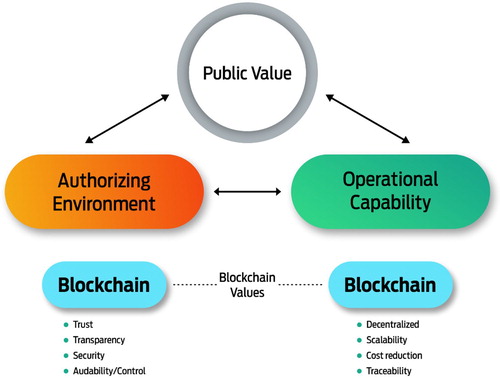
According to Moore (Citation1995), when developing a strategy for the public sector, the person in charge must align these elements coherently, analyzing three steps. Initially, one must assess whether the strategy has value in the sense that the public organization returns value to society, considering the low cost of the strategy from both the financial and authoritative perspectives. Second, the strategy must be legitimate and politically sustainable; that is, an organization must maintain the continuing interests of the authority and the funding of the authorizing political environment. Finally, the demand for the strategy must be viable both operationally and administratively so that authorized activities, in addition to being valued, can be performed by the organization and with the support of other stakeholders, all focusing on the organization.
The strategic triangle works to encourage employees to focus their attention on their operating environments to support mission definitions, overall organization objectives, and demand execution, thereby enabling a greater use of the strategic concept and value assessment of the society. The approach is a powerful way to assess whether there is a balance between the elements, as it allows the assessment of all the conditions necessary for value production in the public sector.
The theory has been updated (Benington & Moore, Citation2011) to address the rapid change in government management and to engage with more practical issues, such as the measurement and assessment of public value. The theory has also been expanded to analyze value in different disciplines (ecology, economics, history and political sciences, among others), different countries (developed, emerging and underdeveloped) and different areas of society (education, health, pension and environment).
Some articles have already used the public value theoretical lens to analyze phenomena involving the use of technology in government management and have pointed to sustainability as one of the existing public value types. These studies have also demonstrated that public value can be optimized through technology (Karunasena & Deng, Citation2012).
Thus, we believe that public value theory can contribute to elucidating our research question since it allows us to interpret the perceived value of blockchain in the public and private sectors during environmental investment negotiations. As a recent technology, blockchain still presents problems that are not fully understood, such as attack risks, low levels of maturity, regulation, and usability (Ferreira et al., Citation2017).
Hartley et al. (Citation2017, p. 680) identified a lack of empirical research that uses public value theory, and we decided to follow their second proposed approach, ‘examining the contestation of public value through dynamic social issues’. According to these authors, ‘the key element of this research is that different stakeholders, both in public and in private interactions, express their values and reach some degree of compromise or consensus (or not) over an issue’. (Hartley et al., Citation2017, p. 680)
The public value theory framework may also help us analyze the function of the technology applied in government services and inspire IS researchers and public managers to design sustainable business models in complex contexts involving blockchain.
3. Methodology
We used the case study strategy with an interpretative perspective (Stake, Citation1995, Citation2000 and Citation2008). We conducted semistructured interviews with leading public and private sector managers. We triangulated the data with the set of documents we collected (decrees, laws, official journal publications, and consultations on government platforms). The interviews were conducted on a long-term basis from November 2018 to July 2020 as the companies joined the program. The selected interviewees were two State Secretaries, three representatives of the technology supplier, and seven CEOs from the companies that first joined the program. These companies were from different sectors/industries, as described in .
Table 1. Interview distribution.
Atlas.ti software supported the data treatment and coding. We used a content analysis technique inspired by Miles and Huberman (Citation1994), and the first-order categories were the dimensions or processes that formed the strategic triangle. In addition to interviews and documentation triangulation, a participative observation was carried out by one of the researchers, who is the current Planning Secretary and one of the persons in charge of the AGT project. Having him on the research team was essential to access the State Secretaries and all the companies. He produced the reports and minutes of 16 meetings between key actors. This researcher collected the government data, while the interviews in the private sector and the transcription and codification of data based on public value theory were carried out by the other researchers, all of whom sought to maintain the commitment to neutrality, validity, and reliability in data interpretation. The results of these 16 meetings () were significant for the case description. The meetings demonstrate the search for examples of strategic partnerships, such as presentations for replication in some other Brazilian states (such as the members of the Legal Amazon Consortium – GCFTF, Citation2019) or investment opportunities through private banks. The meetings also show the goal of accreditation by international institutions, such as the World Bank, to support and insert the program into the global market.
Table 2. Meeting agenda of the AGT.
To construct chapter 4.2 – Blockchain infrastructure designed by BMV – we performed interviews with the technology supplier with the support of the framework called ‘summary of proposed public value measurement dimensions’ designed by Faulkner and Kaufman (Citation2018, p. 77), which divides public value measurement into 4 dimensions, such as (1) outcome achievement (social, economic and environmental outcomes); (2) trust and legitimacy (transparent and fair process); (3) service delivery quality (client satisfaction, accessibility and convenience); and (4) efficiency (minimal bureaucracy, benefits outweigh costs). The results of this phase are described in chapter 4.2.
Using Moore’s theoretical model, we analyzed the interviews and documents along 3 dimensions: public value, authorizing environment, and operational capacity.
The twelve interviews were an average of 20 min each, and audio was recorded for each. The interviewees were public and private executives, and due to schedule restrictions, we opted for interviews that lasted up to 30 min. For this purpose, we constructed 3 pillars of analysis based on the public value theory framework: (1) identify the value perception of the certification technology, in this case blockchain, for each of the actors; (2) ensure that the environment for the implementation of the AGT, more precisely the relations among the actors, facilitates the negotiation of forest credits between the public and private sectors; and (3) verify that the blockchain enhances operational capacity, generating benefits such as security, transparency and traceability.
4. The case of the Amapá Green Treasure (AGT)
The issue of environmental services – covering the public policy bias – has been addressed internationally since 1972 at the Stockholm Conference. This issue evolved with milestones such as the Rio 92 (1992), Kyoto Protocol (1997), 2000 Millennium Development Goals, the Millennium Summit (2010), Rio + 20 (2012), Agenda 2030 (2015), and finally the Paris Agreement, which was launched in 2015 and signed between 2016 and 2017 (Kamphof, Citation2018).
Two instruments stand out in international climate finance: the 17 Sustainable Development Goals – SDGs (Agenda 2030) and the Paris Agreement. Agenda 2030 and its SDGs guarantee the prominence and transversality of the climate agenda into which the environmental services are integrated. The Paris Agreement establishes a climate ceiling maximum of 2°C concerning the emissions levels of the preindustrial era and provides principles, strategies, and instruments for the Agenda. This commitment – within the framework of international law – has strengthened the market for environmental services that are integrated into the carbon market and designed to transpose mitigations and adaptations to the financing of global sustainability.
Currently, the market includes four kinds of carbon pricing initiatives: emissions trading systems (ETSs), offsetting mechanisms, carbon taxes, and results-based climate finance (RBCF), which generated USD 45 billion in public revenues in 2019 according to the World Bank (Citation2020). These initiatives are expected to reach the USD 100 billion per year goal, and the funds should be invested in measures to combat climate change, as set out in the Paris Agreement. This goal was reiterated at the last United Nations Climate Change Conference (COP 24, in 2018), which supports the global market for environmental services that has not yet been accessed by the State of Amapá.
Amapá is one of the 26 Brazilian states situated in the north of the country in the Amazon region. The state’s current economic matrix is unsustainable: the main activity is public administration (more than 50% of its GDP). This activity is followed by commerce and the construction industry, which has direct links to public purchases: that is, the state is a subsidized unit that is socioeconomically isolated, has precarious logistics and infrastructure and lacks effective and inclusive opportunities for its population. According to the latest Earth Innovation Institute study presented at the Governors’ Climate and Forests Task Force meeting in San Francisco (CA) in September 2018, Amapá is one of the most preserved subnational states in Brazil and the Amazon, but this is not reflected in its GDP.
With more than 90% of its territory preserved, the state was excluded from the environmental service market until 2018. As a substantial and effective alternative to enter the market for environmental services, the Amapá Green Treasure program (AGT) was created: based on national and local legislation, the AGT was designed to measure the environmental services that have always been provided by the most preserved areas of Amapá to foster a sustainable economic matrix. This is a solution that provides dignity and enables the inclusion of the communities that protect the forest, making the economic activity of nature preservation feasible, while financing public policies related to the SDGs and other integrated programs exclusively aimed at sustainable development.
The public policy is supported by a collaborative network that includes a forest inventory that is compiled according to international standards and has been registered with the UN and is known as the BMV (Brasil Mata Viva) Standard. This standard has been validated by the Universidade Estadual Paulista (UNESP) and verified by Ernst & Young (E.Y.). The inventory allows the issuance of a Rural Product Certificate that, after registering with the Central Custody and Financial Settlement of Securities (CETIP) and being placed under the legal custody of Julian Turnbull, generates a forest credit offered through an online platform by BMV. This process flow is shown in .
The forest credit can originate with private properties – as has happened for more than 10 years in the States of Mato Grosso and Amazonas – and public areas, as has been initiated in the State of Amapá. However, unlike other methodologies that work with future commitments, the credit is issued based on the environmental services rendered in the last 12 months. Another advantage of the BMV Standard in relation to other methodologies is the real guarantee deposit – the native wood is preserved, and the forest credit is not subject to risks in case of deforestation since it is issued based on the service already provided. In addition, concerning valuation, the focus is on precisely valuing the intact forest, removing the economic advantage of forest degradation and making other economic activities more attractive.
The online platform aims to provide security, transparency and traceability through the registration of all transactions in a blockchain, to allow exits to the financial system and secondary markets and to achieve the Sustainability Seal – the main focus of the program – which is obtained by calculating the footprint access to green economy policies. The seal consumes forest credit, transforming it into income for public administration and for rural producers.
The seal represents the socioenvironmental contribution of the resources used during one year of activity by a particular company or an individual and adds an objective criterion to verify the commitment to sustainability. For example, the issuance of green bonds involves a variety of initiatives used to raise funds in the financial market, which are generally linked to an industrial process (e.g. reduction of toxic gases) or to economic activity itself (e.g. renewable energy and use of waste), towards a sustainable economic matrix.
The Green Treasure now provides a new essential criterion, by including intact forests, which can be used as a requirement through bilateral and/or multilateral agreements and internalized through public policies, as carried out by Amapá. It is an objective way of guaranteeing the protection of the Amazon rainforest by calculating the ecological footprint in a way that integrates the balance of the companies, adding environmental support to their brand.
The seal is acquired by companies on the platform. The companies are identified so that they can access incentive mechanisms launched to encourage the AGT. The concession of tax benefits and the selection of assets for investment by the social security institute are examples that have already attracted the support of companies. Amapá can establish having the seal as a requirement for accessing public incentive mechanisms and benefits, increasing the attractiveness of the program. The most recent example, with an effective potential do scale the program, is the ‘Refis Verde’, the first ICMS tax regulation program (State VAT – value-added tax), which guarantees differentiated discounts for companies with the Sustainability Seal. An inniative aimed at stimulating the economy to face the effects of the pandemic, allowing entrepreneurs to restore their fiscal regularity while promoting AGT’s sustainability policies.
4.1. The green bonds market
Confirming UNEP (Citation2016) estimates, USD 100 billion per year is the amount that should be invested in measures to combat climate change, as set out in the Paris Agreement that was signed in 2015 and approved by 195 countries. This goal was reiterated at COP 24 (UN, Citation2018), which supports a world market for environmental services that have not yet been accessed by Amapá. The issue is addressed in the international agreement, specifically in Article 6, which addresses ‘market mechanisms’, thus enabling signatory countries to meet a part of their mitigation targets.
Unlike adaptation, another focus of the agreement, mitigation, can be achieved through this international market for environmental services, commonly referred to as the carbon market, with emissions trading through instruments such as carbon credits, which represent 1 ton of stockpiled CO2. In this sense, the Paris Agreement seeks to contribute to the regulation of this world market, guiding the construction of a safe environment through transactions and accounting for emissions and environmental services.
Currently, the market offers a variety of solutions, such as carbon pricing itself, which can range from less than USD 1/t CO2 to as much as USD 139/t CO2, which in 2017 alone generated $33 billion in government revenue according to the World Bank (Citation2018). Regardless of the variations, the numbers are growing sharply, supported by Article 6 of the Paris Agreement, operating primarily through two major groups of solutions: the Emissions Trading System (ETS) and the carbon taxes and results-based climate finance (RBCF). from the latest World Bank report (Citation2018, p. 12) confirms the relevance of this market.
It is also worth mentioning the green bond market, which is intended to finance the green economy through the use of tradable securities in the financial market, as in the experience of BNDES (Brazilian Bank of Development) in 2017, in the amount of R$1 billion. The global market, estimated at USD 635 billion according to the CBI (Citation2019a, p. 2), is presented in .
In this context, there is a growing worldwide movement in the public sector to use green bonds to finance infrastructure and initiatives related to the climate agenda and SDGs. According to CBI (Citation2019b, p. 2), USD 24.8 billion was issued by the public sector in 16 countries in the first half of 2019 alone, up by 23% from the same period last year, as shown in .
4.2. Blockchain infrastructure designed by BMV
To understand the blockchain infrastructure behind the AGT, we performed interviews with Brasil Mata Viva (BMV), a collaborative network that develops sustainable solutions and is the government technology supplier for this project (Brasil Mata Viva, Citation2019). After developing the forest credit methodology, BMV started to look for blockchain applications in 2017 with the intention of avoiding double selling, a problem that emerged in the past with regard to carbon credit negotiation in Brazil.
Pan et al. (Citation2019) confirm that ‘the goal of blockchain technology in the energy industry is to provide a fully decentralized energy system that can be communicated directly between producer and consumer’ (p. 4287). These authors reinforce that to provide safety and reliability, ‘each record will have a timestamp and a unique cryptographic signature, which ensures that each transaction can be traced back to the historical record’ (Pan et al., Citation2019, p. 4288).
In 2017, BMV examined over 50 blockchain options in the market and found that Bitcoin and NXT (nxt.org, 2019) were more mature than the others. The network chose NXT for two reasons: (1) NXT worked with a proof of stake (POS) protocol while Bitcoin worked with a proof of work (POW), which consumes more energy and therefore did not make sense as a sustainable asset; (2) NXT had a well-developed wallet that was multilingual and had the best user experience. BMV had to consider that its main customers are farmer-owners, a public group with a low level of digital skills for participating in complex systems.
Following Casino et al.’s (Citation2019) blockchain classification, NXT can be considered a public blockchain network running a POS protocol (from a hyperledger consortium) designed for a government project to provide transparency in the public administration of forest credit negotiations.
It is important to emphasize that the USC (Unit Sustainability Credit) negotiated by the AGT is not a coin. The USC is equivalent to 1 forest credit and is an asset with financial value linked to native forest services. For this reason, although the USC’s economic value is approximately BRC 77 (2019), it is considered an intangible good. The customer is investing in the benefit already generated by the forest and not in the land or territory. The BMV platform allows total traceability of the farm that generates the credit, and blockchain allows complete accountability for every transaction. An example of the register in NXT is presented in , where we can see the decentralized network registration; in , we show the sustainable seal certificate, which has a QR code that allows the traceability of the farms that generate the forest credit.
The BMV is planning to enter blockchain generation 4.0, which includes a security token and a more sophisticated smart contract design. Due to this decision, BMV may change to the Ethereum network, which allows several types of smart contracts that can include AGT in the international green bond market. Compliance is critical in this process because every investment is traded through the platform. BMV is also accountable to the government.
The next step for the government is to include the traceability of investments, which is already included in the government’s consensus protocol, in the sustainable objectives to return public value to society: the distribution of the investment amount (Graph 1). After this implementation, we may consider total traceability in forest credit negotiation trading, which may attract different investor profiles.
Concerning blockchain applications in the government context, Casino et al. (Citation2019, p. 63) hold that ‘the accountability, automation, and safety that blockchain offers for handling public records could eventually obstruct corruption and make government services more efficient’. It is also noteworthy that the added value of blockchain is in compliance, especially regarding the possibility of additional controls, by adding security and transparency to the other public sector governance instruments (strict budget execution, internal and external control bodies, publicity of acts, accountability). Beyond the strict regulation over revenues and expenses related to the program, blockchain allows traceability and transparency of the asset transactions, enabling monitoring of the flow from the origin of the assets to the generation of public funds.
5. Data analysis
We started our analysis in the two dimensions in which blockchain benefits can contribute to public value generation: authorizing environment and operational capacity, according our conceptual model (). During the data analysis, we found the contribution of blockchain as part of an innovative solution and public value legitimization, as manifested in the outcome, the Green Treasure Seal.
For the authorizing environment, we understand the relationship between public and private organizations and society in general. As shown in , in the dimension ‘authorizing environment’, we found the demand for trust, transparency and security from the private to the public sector during environmental investment negotiations. For the public sector, auditability is a benefit that blockchain offers, and it is critical for international compliance requirements of the green bonds market.
Table 3. Data analysis summary.
The private sector clearly stated their concern about the double selling that occurred in the past with carbon price initiatives (Redd, Citation2015). During AGT investments, the vast majority of the companies agreed that blockchain offers trust, transparency, and security. Another observation regarding competition was that AGT was the first investment option for environmental impact compensation with a blockchain platform and BMV methodology, a combination recognized as an innovative technology solution for sustainable services negotiations.
In operational capacity, we identified the demand the public sector addresses to the technology supplier. Blockchain can contribute to public value generation primarily because it is a decentralized network. The public sector confirmed that an innovative technology solution was necessary to integrate all the actors involved, and the BMV solution with a blockchain platform was their choice because it delivered the required operational capacity.
As we shown in , blockchain was able to offer a decentralized network (original characteristics of the technology), traceability, and a low operational cost (interviewee’s perception) together with the associated benefits. From one of the technology supplier interviews, traceability is ‘one of the things that really differentiates and highlights the market that existed before the carbon credit’.
The companies that have a direct relationship with their final customer (business to consumer – B2C) declared that their customers also recognized the value of the sustainable seal and that the cost related to the consumption compensation is low, ‘an example of a collective awareness’ (CEO – E).
Related to scalability, it is not possible to verify gains since the program is new and in the process of acquiring maturity. However, respondents expect this blockchain feature.
6. Discussion
Our interview script contained open questions about what types of contributions the AGT and the embedded certification technology (in this case, blockchain) offered. According to theory, public value is closely related to the common good. In the content analysis, we remarked on this specific point: the AGT project is directly related to the objective of sustainability.
The pressure for sustainable economic growth is an external force pressuring government and society for the generation of public value. When environmental investments are negotiated, in the process of creating an authorizing environment (a coalition of key actors from the private sector, government, and regulatory entities), there is a demand for trust, transparency, security, and accountability. The public sector responds with innovative solutions supported by blockchain platforms combined with network methodologies such as BMV. Blockchain is able to enhance operational capacity through decentralization, cost reduction, scalability and traceability, generating the cycle of public value generation shown in . The cycle is completed when the public value is legitimated by society, in our case, investors, regulators, and the final customers of the enterprises adopting the Green Treasure Seal. This analytical framework summarizes the findings of our research and answers the research question.
In the specific case, the external pressure for sustainable development can be represented by the Paris Agreement, signed by 195 countries, and by the positioning of world leaders such as Angela Merkel: ‘we need a financial market that provides cheap capital for climate-friendly investments.’ (D.W., Citation2020). Seeking to respond to the external pressure, the State of Amapá demanded an innovative solution that could offer security (e.g. checks from UNESP and E.Y. explained in ), transparency and traceability (blockchain values), supported by public policies. It was necessary to increase the operational capacity to deliver the AGT with the values of blockchain: decentralized control, low cost, and traceability. Concluding the framework, the recent adherence of financial market institutions like AZ Quest demonstrates the generation of public value, proving the perception of investors that the Program is a response to the pressure for sustainable development and demonstrating a consensus (Hartley et al., Citation2017, p. 680) between the public and the private sectors:
Modern entrepreneurship says that it is always possible to combine profit with a purpose, managing companies so that they become a vector of social development and benefit for all those who are directly or indirectly impacted by their activity. For years we have tried to conduct AZ Quest’s activities with these principles. As part of our environmental sustainability strategy, we adhered to and obtained the Sustainability Green Treasury Seal, for investing in the conservation of native forests and the production of ecosystem services effectively and transparently. (LINKEDIN AZQUEST, Citation2020)
Our findings suggest three considerations:
Our findings demonstrate the values of trust, transparency and security being clearly recognized by the private sector through the AGT platform and the embedded technology. In a South American country where concerns around corruption exist, the offer of these values is crucial in building trust between partners. The identification of investors in the implemented solution (transparency) allows companies to be validated and makes them able to claim other incentives.
The territory of the State of Amapá is mainly rainforest. The Green Treasure Seal can be a leapfrogging mechanism to offer an investment opportunity in an isolated region of the Amazon. This is the first offer of these seals, which has attracted the interest of international multilateral agencies in addition to national companies and has facilitated access to the global market.
In the context of lack of the infrastructure in the Amazon region, blockchain facilitates operational capacity.
Benington and Moore (Citation2011, p. 262) emphasize the importance of legitimacy from society to achieve public value: ‘The concept of public value acts as a guide to search out conditions that need to be improved, and problems that need to be addressed, but are not necessarily the responsibility of any single agency’. In this case, AGT needs to scale to achieve it. It is important that the private sector adopt platforms such as AGT to create new business opportunities. These sustainable platforms allow several kinds of configurations to transform standard business into green market solutions.
Public value theorists also question ‘how much room there is for innovation in the government’ (Benington & Moore, Citation2011, p. 263). Blockchain technology emerges as a potential alternative to generate public value, primarily through better management of resources, that should offer returns for the benefit of society. During our field work, we could sense the recognition of the power of the word blockchain in the context of innovation, from small business executives to banks and multilateral agencies.
7. Conclusion
The main purpose of this study was to identify how blockchain can contribute to the negotiation of environmental investment between the public and private sectors. Amapá is a remote area in the Amazon region. A Brazilian state with a small population, the territory is covered by native rainforest and is seeking sustainable economic growth. In the context of resource restrictions and an enormous demand for trust, we argue that blockchain was able to contribute to delivering public value.
We recognized the contributions of blockchain in the specific and intricate context of economic pressure for sustainable growth. Blockchain helped in (1) building the authorizing environment, (2) contributing to the design of an innovative solution, (3) enhancing operational capacity and (4) legitimizing the final outcome.
Our framework illustrates the connections between the potential benefits of blockchain and public value theory. The economic pressure for sustainable growth was the trigger to start the project, possibly due to the difficulty of fundraising that the State of Amapá experiences. The authorizing environment is the coalition of key actors capable of legitimizing specific actions and guaranteeing their sustainability. For this to be effective, some vital issues are trust, security, transparency, and auditability or control, especially within the private sector. The demand for trust required an answer from the government in terms of an innovative solution supported by a blockchain platform. In the context of a lack of resources, operational capacity could benefit from the blockchain characteristics of decentralization, cost reduction, and traceability. The certified final outcome (in this case, the Green Treasure Seal) is the mechanism of public value legitimization. Scalability was the only blockchain characteristic not verified due to the novelty of AGT.
In the private sector, there is a collective awareness to compensate for the environmental impact and generate sustainable growth, from small to large businesses. The executives interviewed did not dominate the technical issues of blockchain. Nevertheless, the majority of executives interviewed recognized the contribution of blockchain to generating public value, with security as the value most often mentioned, mainly to avoid double selling and guarantee the proper distribution of resources to society.
We must emphasize the importance of the synergy between the actors in a project such as this one, which has sustainable objectives but also considerable challenges to face. We find that even with government efforts, if the market and society do not actively participate and contribute to conservation and a new green economy, even with the right infrastructure and technology, the project is not feasible. The responsibility for generating public value in all dimensions of sustainability belongs to a large group of social actors with diverse interests.
We described an application of blockchain for the common good, as suggested by Kewell et al. (Citation2017), through projects that contribute to the UN’s sustainability agenda in countries of the Global South, as Kshetri (Citation2017a, Citation2017b) suggests. As a first contribution, the case description itself can stimulate insights in public managers and IS scholars working on the design of sustainable business models in emerging and developing countries. The second contribution is the explanation of the contribution of blockchain to create public value. The use of the public value theory perspective for the blockchain phenomenon fills one of the research gaps identified in our literature review. The lack of applied cases, another observed research gap, was also filled with this study since it demonstrates a practical case of the blockchain in projects that promote sustainability in government.
AGT is a very recent project that was launched in August 2018 and is therefore in the process of acquiring maturity, which limited our research on the number of operations performed for analysis. When AGT achieves scalability, we may continue our investigation with a quantitative data collection (such as a survey). One of the opportunities is to measure the public value among citizens, for instance, concerning the trust, legitimacy, service delivery quality, and efficiency of the blockchain application, as proposed by Faulkner and Kaufman (Citation2018). The second-order effects are a hot topic around blockchain technology and sustainability. Because the use we investigate is entirely new and recent, there is no current perception of second-order effects, and we were not able to include second-order effects in our discussion. We consider this topic an opportunity for future studies.
Disclosure statement
No potential conflict of interest was reported by the author(s).
Additional information
Funding
Notes on contributors
Edson Corrêa Tavares
Edson Corrêa Tavares is a Phd Researcher at the Center of Applied Information Technology of São Paulo Business School from Getulio Vargas Foundation (FGV EAESP). Foreign Trade and Innovation Specialist, MSc in Business Administration (FGV EAESP), MBA in Logistics (FGV EAESP).
Fernando de Souza Meirelles
Fernando de Souza Meirelles is a Full Professor and former Dean at the Sao Paulo Business School from Getulio Vargas Foundation (FGV EAESP). Engineer (IMT), MSc in Engineering Management (Stanford), PhD (FGV) and graduate courses at Harvard, MIT and University of Texas. Consultant and Board member of several companies, associations and organizations. Researcher at the Center of Applied Information Technology of FGV EAESP.
Eduardo Corrêa Tavares
Eduardo Corrêa Tavares is a State Revenue Auditor, Master in Tax Administration and Public Finance from the Instituto de Estudios Fiscales (IEF) of the Government of Spain and the Universidad Nacional de Educación a Distancia (UNED), and Master's student in Planning and Public Policies from the State University of Ceará - UECE. Since 2018, is the Planning Secretary of the State of Amapá and coordinator of the Amapá Green Treasure (AGT). Current coordinator of the Strategic Planning Chamber of the Interstate Consortium for Sustainable Development of the Legal Amazon.
Maria Alexandra Cunha
Maria Alexandra Cunha is adjunct professor at the Sao Paulo Business School from Getulio Vargas Foundation (FGV EAESP). She holds a Doctorate in Business Administration (USP) and she has been leading academic research and professional projects in ICT governance, digital government, smart cities, smart governance, digital democracy, and on models for administering computerization in governments. At FGV she also leads the IT and Governments area in the Center for Public Administration and Government.
Leandro Marcilio Schunk
Leandro Marcilio Schunk is an Executive Professor at FGV IDE (Getulio Vargas Foundation) and Information Technology Consultant. MBA in Business Management from FGV with an international extension in “Business and Management” from the University of California (Irvine). Researcher at the Center of Applied Information Technology of FGV EAESP.
References
- Benington, J., & Moore, M. H. (2011). Public value: Theory & practice. Palgrave Macmilan.
- BMV. (2019). Brasil Mata Viva official website. http://brasilmataviva.com.br/
- Casino, F., Dasaklis, T. K., & Patsakis, C. (2019). A systematic literature review of blockchain-based applications: Current status, classification and open issues. Telematics and Informatics, 36, 55–81. https://doi.org/10.1016/j.tele.2018.11.006
- CBI. (2019a). Climate Bonds Initiative. Latin America & Caribbean Green finance state of the market 2019. Retrieved September 25, 2019, from https://www.climatebonds.net/resources/reports/latin-america-caribbean-green-finance-state-market-2019
- CBI. (2019b). Green bonds market summary – H1 2019. Retrieved September 25, 2019, from https://www.climatebonds.net/resources/reports/green-bonds-market-summary-h1-2019
- Denny, D. M. T., Paulo, R. F., & Castro, D. (2017). Blockchain e Agenda 2030. Revista Brasileira de Políticas Públicas, 7(3), 121–141. https://doi.org/10.3366/ajicl.2011.0005
- Diniz, E. H. (2017). Emerge uma nova tecnologia disruptiva. GV-executivo, 16(2), 46–50. https://doi.org/10.12660/gvexec.v16n2.2017.68676
- D.W. (2020). Germany's Angela Merkel calls for ‘climate friendly’ coronavirus response. Retrieved August 27, 2020, from https://www.dw.com/en/germanysangela-merkel-calls-forclimate-friendly-coronavirusresponse/a-53272768
- Engelenburg, S., Janssen, M., & Klievink, B. (2017). Design of a software architecture supporting business-to-government information sharing to improve public safety and security. Journal of Intelligent Information Systems, 1–24. https://doi.org/10.1007/s10844-017-0478-z
- Faulkner, N., & Kaufman, S. (2018). Avoiding theoretical stagnation: A systematic review and framework for measuring public value. Australian Journal of Public Administration, 77(1), 69–86. https://doi.org/10.1111/1467-8500.12251
- Ferreira, J. E., Pinto, F. G. C., & Santos, S. C. (2017). Estudo de Mapeamento Sistemático sobre as Tendências e Desafios do blockchain. Gestão.Org, 15, 108–117. https://doi.org/10.21714/1679-18272017v15Ed.p108-117
- Fowler, M. D. (2018). Linking the public benefit to the corporation: Blockchain as a solution for certification in an age of “do good” business. Vanderbilt Journal of Entertainment and Technology Law, 20, 1–42.
- GCFTF. (2019). Governors of the Brazilian Amazon agree to create a consortium. Retrieved April 10, 2020, from https://www.gcftf.org/post/governors-of-the-brazilian-amazon-agree-to-create-consortium
- Hartley, J., Alford, J., Knies, E., & Douglas, S. (2017). Towards an empirical research agenda for public value theory. Public Management Review, 19(5), 670–685. https://doi.org/10.1080/14719037.2016.1192166
- Hawlitschek, F., Notheisen, B., & Teubner, T. (2018). The limits of trust-free systems: A literature review on blockchain technology and trust in the sharing economy. Electronic Commerce Research and Applications, 29, 50–63. https://doi.org/10.1016/j.elerap.2018.03.005
- Issa, H. (2018). AIS research and government accounting research compared: Special section of JETA on the use of AIS technology in government reporting. Journal of Emerging Technologies in Accounting, 15(1), 103–106. https://doi.org/10.2308/jeta-10590
- Kamphof, R. (2018). The European Union: Patterns of collaboration with international environmental and climate institutions. Working Paper Series. United Nations University. http://cris.unu.edu/sites/cris.unu.edu/files/W-2018-5_0.pdf
- Karunasena, K., & Deng, H. (2012). Critical factors for evaluating the public value of e-government in Sri Lanka. Government Information Quarterly, 29(1), 76–84. https://doi.org/10.1016/j.giq.2011.04.005
- Kewell, B., Adams, R., & Parry, G. (2017). Blockchain for good? Strategic Change, 26(5), 429–437. https://doi.org/10.1002/jsc.2143
- Kokina, J., Mancha, R., & Pachamanova, D. (2017). Blockchain: Emergent industry adoption and implications for accounting. Journal of Emerging Technologies in Accounting, 14(2), 91–100. https://doi.org/10.2308/jeta-51911
- Kshetri, N. (2017a). Blockchain’s roles in strengthening cybersecurity and protecting privacy. Telecommunications Policy, 41(10), 1027–1038. https://doi.org/10.1016/j.telpol.2017.09.003
- Kshetri, N. (2017b). Will blockchain emerge as a tool to break the poverty chain in the Global South? Third World Quarterly, 38(8), 1710–1732. https://doi.org/10.1080/01436597.2017.1298438
- Kshetri, N. (2018). 1 blockchain’s roles in meeting key supply chain management objectives. International Journal of Information Management, 39, 80–89. https://doi.org/10.1016/j.ijinfomgt.2017.12.005
- LINKEDIN AZQUEST. (2020). There is no long term without preserving nature. Retrieved August 27, 2019, from https://www.linkedin.com/posts/az-quest-investimentos-ltda_azquest-fundosdeinvestimento-sustentabilidade-activity-6701570837432164352-WnUB/
- Macrinici, D., Cartofeanu, C., & Gao, S. (2018). Smart contract applications within blockchain technology: A systematic mapping study. Telematics and Informatics, 35(8), 2337–2354. https://doi.org/10.1016/j.tele.2018.10.004
- Manski, S. (2017). Building the blockchain world: Technological commonwealth or just more of the same? Strategic Change, 26(5), 511–522. https://doi.org/10.1002/jsc.2151
- Miles, M. B., & Huberman, A. M. (1994). Qualitative data analysis: An expanded sourcebook. Sage.
- Moore, M. H. (1995). Creating public value: Strategic management in government. Harvard university press.
- Moore, M. H. (2002). Criando valor público: gestão estratégica no governo. Uniletras.
- Nakamoto, S. (2008). Bitcoin: A peer-to-peer electronic cash system.
- Notheisen, B., Hawlitschek, F., & Weinhardt, C. (2017). Breaking down the blockchain hype–towards a blockchain market engineering approach, 1062–1080. https://pdfs.semanticscholar.org/9f21/9d266984blockchainf1589c77080439f06d49465c69.pdf
- Ølnes, S., Ubacht, J., & Janssen, M. (2017). Blockchain in government: Benefits and implications of distributed ledger technology for information sharing. Government Information Quarterly, 34(3), 355–364. https://doi.org/10.1016/j.giq.2017.09.007
- Pan, Y., Zhang, X., Wang, Y., Yan, J., Zhou, S., Li, G., & Bao, J. (2019). Application of blockchain in carbon trading. Energy Procedia, 158, 4286–4291. https://doi.org/10.1016/j.egypro.2019.01.509
- Redd. (2015). Who takes the credit? The risks of double-counting in a REDD carbon trade mechanism. Retrieved April 11, 2020, from https://redd-monitor.org/2015/06/11/who-takes-the-credit-the-risks-of-double-counting-in-a-redd-carbon-trading-mechanism/
- Risius, M., & Spohrer, K. (2017). A blockchain research framework. Business & Information Systems Engineering, 59(6), 385–409. https://doi.org/10.1007/s12599-017-0506-0
- Saberi, S., Kouhizadeh, M., & Sarkis, J. (2018). Blockchain technology: A panacea or pariah for resources conservation and recycling? Resources, Conservation & Recycling, 130, 80–81. https://doi.org/10.1016/j.resconrec.2017.11.020
- Souza, L. M. D., Saad, M. L. M., & Faria, E. M. (2015). Value-for-money e geração de valor público na atuação das organizações sociais de saúde: contribuições para o governo do estado de São Paulo (Doctoral dissertation).
- Stake, R. E. (1995). The art of case study research. Sage Publications, Inc.
- Stake, R. E. (2000). Case studies. In N. K. Denzin & Y. S. Lincoln (Eds.), Handbook of qualitative research (pp. 435–453). Sage.
- Stake, R. E. (2008). Qualitative case studies. In N. K. Denzin & Y. S. Lincoln (Eds.), Strategies of qualitative inquiry (pp. 119–149). Sage.
- Stickler, C., Duchelle, A. E., Ardila, J. P., Nepstad, D., David, O., Chan, C., Rojas, J. G., Vargas, R., Bezzera, T., Pritchard, L., & Simmonds, J. (2018). The state of jurisdictional sustainability: Synthesis for practitioners and policymakers. Earth Innovation Institute. https://earthinnovation.org/publications/the-state-of-jurisdictional-sustainability-synthesis-for-practitioners-and-policymakersvan
- Tesouro Verde. (2019). Plataforma Tesouro Verde official website. https://www.plataformatesouroverde.com.br/
- UNEP. (2016). Programa das Nações Unidas para o Meio Ambiente. O sistema financeiro de que necessitamos: do impulso à transformação. Outubro de 2016. Retrieved June 15, 2019, from http://wedocs.unep.org/handle/20.500.11822/20723
- UN (ONU). (2018). Organização das Nações Unidas. Países chegam a consenso na implementação do Acordo de Paris para o clima. Retrieved January 4, 2019, from https://nacoesunidas.org/paises-chegam-a-consenso-na-implementacao-do-acordo-de-paris-para-o-clima/
- World Bank. (2018). State and trends of carbon pricing 2018. Retrieved February 3, 2019, from https://openknowledge.worldbank.org/handle/10986/29687
- World Bank. (2020). State and trends of carbon pricing 2020. Retrieved November 3, 2020, from https://openknowledge.worldbank.org/handle/10986/33809
- Wu, J., & Tran, N. K. (2018). Application of blockchain technology in sustainable energy systems: An overview. Sustainability, 10(9), 3067–3067. https://doi.org/10.3390/su10093067
- Yli-Huumo, J., Ko, D., Choi, S., Park, S., & Smolander, K. (2016). Where is current research on blockchain technology? – A systematic review. PLoS One, 11(10), 1–28. https://doi.org/10.1371/journal.pone.0163477

